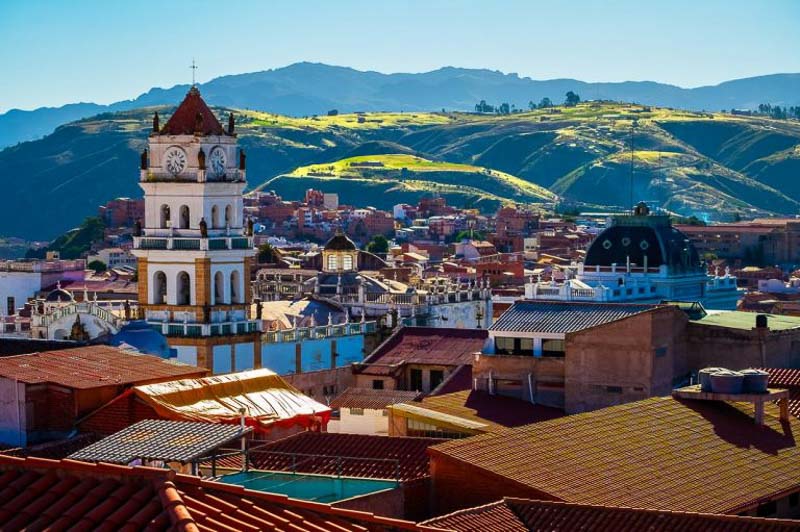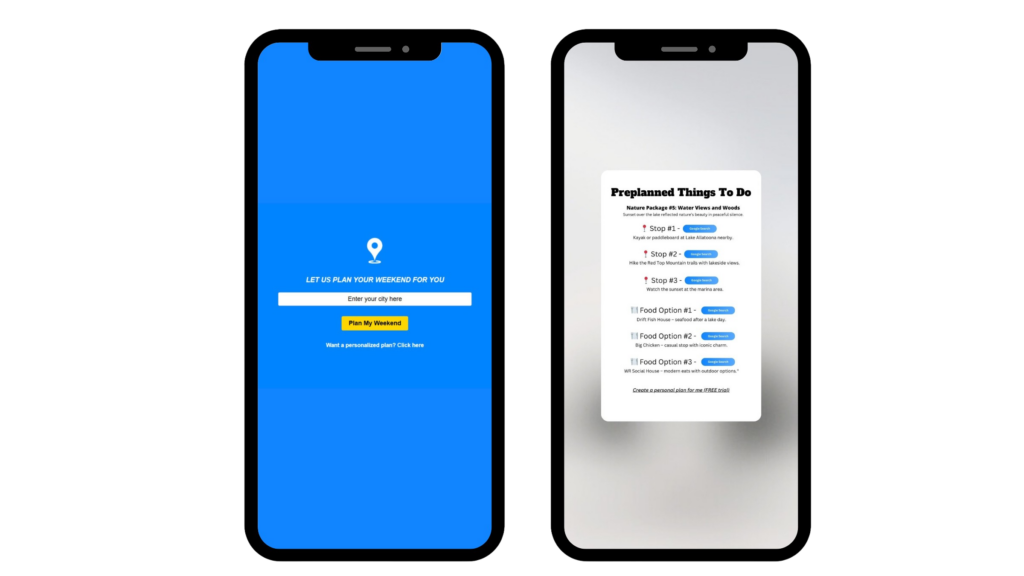
Key Takeaways:
-
Sucre offers a mix of colonial charm, vibrant markets, and outdoor escapes year-round.
-
Visitors can explore museums, hike to panoramic viewpoints, and enjoy cultural festivals in every season.
-
It’s a walkable, affordable city filled with history, student energy, and photogenic scenery.
Sucre, Bolivia’s constitutional capital, is a city that feels like it was frozen in time. With whitewashed colonial buildings, red-tiled roofs, and historic churches at every turn, it’s one of the best-preserved cities in South America—and a UNESCO World Heritage Site. But beyond its postcard-perfect looks, Sucre pulses with life. It’s home to Bolivia’s oldest university, thriving markets, dinosaur tracks, and a laid-back vibe that makes visitors want to linger. Thanks to its mild climate, low prices, and high cultural value, Sucre is a top destination to explore any time of the year.
Table of Contents
-
Climb to the Mirador Recoleta for Panoramic City Views
-
Visit the Museo Casa de la Libertad
-
Explore the Local Life at Mercado Central
-
See Real Dinosaur Footprints at Cal Orck’o
-
Relax in Parque Bolívar’s European-Style Gardens
1. Climb to the Mirador Recoleta for Panoramic City Views
The Mirador Recoleta is Sucre’s most iconic viewpoint and a must for any visitor. Located at the top of a gentle hill, it offers sweeping views over the city’s red rooftops, church domes, and surrounding mountains. The plaza is fronted by a historic convent and arched walkway that frames the perfect photo. Nearby cafés serve fresh juice and coffee, making it an ideal morning or sunset spot.
The climb is short and scenic, and it’s accessible year-round thanks to Sucre’s mild climate. Musicians and artists often perform in the square, adding life to the already magical view. Whether you go for the photos, the peaceful energy, or the chance to just sit and take it all in, Mirador Recoleta is a place you’ll want to return to.
2. Visit the Museo Casa de la Libertad
This museum is one of Bolivia’s most historically important buildings—it’s where the country’s declaration of independence was signed in 1825. Housed in a former Jesuit university building, it now showcases revolutionary artifacts, colonial art, and portraits of Bolivia’s presidents. The architecture is as stunning as the exhibits, with high ceilings, wooden balconies, and a central courtyard.
Open year-round with affordable entry and guided tours, the Casa de la Libertad gives context to Bolivia’s struggle for independence and its evolving national identity. It’s a great stop for history buffs or anyone wanting to understand the soul of Sucre beyond its pretty façades. Plan to spend at least an hour soaking in the knowledge and ambiance of this well-preserved landmark.
3. Explore the Local Life at Mercado Central
Sucre’s Mercado Central is a sensory experience and one of the best places to feel the city’s heartbeat. Inside, you’ll find stalls overflowing with tropical fruit, fresh cheese, spices, meats, and colorful textiles. On the upper level, local food vendors serve traditional dishes like salteñas, peanut soup, and mondongo. It’s lively, crowded, and endlessly fascinating.
The market is open every day and offers a snapshot of local life that’s real and unfiltered. It’s also one of the best places to try cheap, delicious food and interact with Sucre’s residents. Even if you’re not shopping, walking through the maze of vendors is a cultural adventure in itself. Just bring small bills and an appetite for discovery.
4. See Real Dinosaur Footprints at Cal Orck’o
Just outside the city is Cal Orck’o, home to one of the largest collections of dinosaur footprints in the world—over 5,000 tracks from more than 15 species, preserved in a massive vertical limestone wall. The site is part of a working cement quarry, which makes the prehistoric landscape all the more surreal. You can visit the footprints via a guided tour that also includes the nearby Cretaceous Park, with life-sized dinosaur sculptures and interactive exhibits.
Open year-round, the best time to see the tracks up close is during dry season (May to October), when the ground is firm enough for walking tours. It’s a hit with kids, photographers, and dinosaur lovers of all ages. This experience is uniquely Sucre—blending science, nature, and an unforgettable visual moment.
5. Relax in Parque Bolívar’s European-Style Gardens
Parque Bolívar is Sucre’s central park and a favorite spot for both locals and visitors to unwind. It features tree-lined paths, ornate fountains, a replica Eiffel Tower you can climb, and neoclassical statues that give the park a European feel. On weekends, street performers, families, and food vendors fill the space, creating a lively but relaxed atmosphere.
The park is open daily and shines in every season, offering cool shade in the summer and floral colors in the spring. It’s a great place to people-watch, take a stroll, or enjoy some street food on a bench. Whether you’re recovering from a day of sightseeing or just want to slow down, Parque Bolívar is a scenic and peaceful retreat.
6. Discover Art and Culture at Museo de Arte Indígena
Perched above the city in a beautiful colonial building, the Museo de Arte Indígena highlights Bolivia’s Indigenous textile traditions—especially those of the Jalq’a and Tarabuco peoples. Inside, you’ll find intricate weavings, traditional garments, and interactive exhibits on the symbolism, stories, and processes behind these crafts. It’s both visually stunning and culturally enriching, offering a deeper look into Bolivia’s Indigenous roots. You’ll also find local artisans weaving on-site, keeping ancestral techniques alive.
This museum is open year-round and provides guided tours in English and Spanish. Whether you’re a fan of handmade art or curious about Bolivia’s multicultural heritage, this is a stop that adds real substance to your Sucre experience. Don’t forget to check out the on-site shop for one-of-a-kind handmade souvenirs.
7. Take a Day Trip to Tarabuco Sunday Market
About 1.5 hours from Sucre lies the town of Tarabuco, famous for its traditional Sunday market and vibrant Indigenous culture. Here, locals in ceremonial dress sell handwoven textiles, crafts, produce, and leather goods in one of the most colorful and authentic markets in Bolivia. The market feels like stepping into a time capsule, where Quechua is spoken and centuries-old customs remain strong.
The market happens every Sunday, rain or shine, and is a year-round attraction. You can go independently or as part of a guided tour from Sucre. It’s not just about shopping—it’s about connecting with a community that has preserved its identity for generations. For photographers, culture-seekers, and textile lovers, Tarabuco is a rich and rewarding excursion.
8. Walk Through the Historic Cementerio General
It might sound unusual, but Sucre’s Cementerio General is one of its most beautiful and peaceful places. This historic cemetery features tree-lined walkways, ornate tombs, and quiet gardens, where birds sing and locals come to pay respects or read in silence. Some of Bolivia’s most prominent figures are buried here, and many tombstones are adorned with photographs and family tributes that feel deeply personal.
The cemetery is open daily and is a peaceful stroll year-round. It’s not morbid—it’s reflective, artistic, and a window into Bolivian culture and family values. Respectful photography is welcome, and guided tours are sometimes available. It’s one of Sucre’s most unexpectedly moving experiences.
9. Learn Spanish in One of Latin America’s Best Language Schools
Sucre is known as one of the top places in South America to study Spanish. Dozens of language schools offer immersive courses for all levels, often paired with homestays, cooking classes, and cultural outings. The city’s clean, safe, and friendly environment makes it ideal for solo travelers or anyone looking to slow down and deepen their connection with the culture.
Classes are available year-round, and most schools have flexible schedules and affordable rates. Whether you’re staying a week or a month, learning Spanish in Sucre is a fun, social, and meaningful way to experience the city. You’ll walk away with language skills, local friends, and a deeper appreciation for Bolivian life.
10. Enjoy Live Music and Café Culture in Plaza 25 de Mayo
Sucre’s central plaza is one of the prettiest in Bolivia—framed by colonial architecture, lush palm trees, and buzzing cafés. By day, it’s the perfect spot to sip coffee, watch street performers, or join a walking tour. By night, the plaza lights up with romantic energy, with live music spilling from restaurants and occasional open-air concerts or cultural events.
The plaza is lively year-round and is the heartbeat of the city. It’s where locals meet, travelers rest, and performers entertain. Whether you’re enjoying a quiet moment or joining a crowd, Plaza 25 de Mayo is the place to feel Sucre’s rhythm and connect with its warm community spirit.
What to do if you have kids?
Sucre is one of Bolivia’s most family-friendly cities. The low elevation, mild weather, and walkable streets make it easy to explore with kids. Parque Bolívar has space to run and a fun mini Eiffel Tower, while the dinosaur park at Cal Orck’o is always a hit with little adventurers. Restaurants are generally accommodating, and locals are welcoming to families. With museums, parks, markets, and gentle hikes, there’s plenty for kids to enjoy without overstimulation.
Where can I find free events in Sucre Bolivia taking place this weekend?
If you’re looking for free festivals, concerts, markets, workshops, or family activities in Sucre, check out PlanMyWeekend.ai. Our AI tool curates local events based on your location and interests, saving you time and unlocking hidden gems. Just search “Sucre, Bolivia” and discover what’s happening this weekend—from outdoor movie nights to artisan fairs, cultural parades, and more. It’s your go-to guide for making every weekend in Sucre unforgettable.
Final thoughts
Sucre isn’t just a pretty city—it’s a cultural treasure that rewards those who slow down and dive in. With its timeless beauty, vibrant traditions, and year-round appeal, it offers something for every traveler. Whether you’re wandering cobblestone streets, learning Spanish, admiring Indigenous art, or standing where history was made, Sucre leaves a lasting impression. Come for the colonial charm, stay for the heart and soul—and leave with a deeper understanding of Bolivia.
Author: Dejon Brooks
Dejon Brooks is an entrepreneur who founded Trend Watchers with his life savings. Aged 24, Dejon has turned Trend Watchers into a successful business. After reaching over 150M+ people on his personal accounts, he now spends his time growing Planmyweekend.ai


